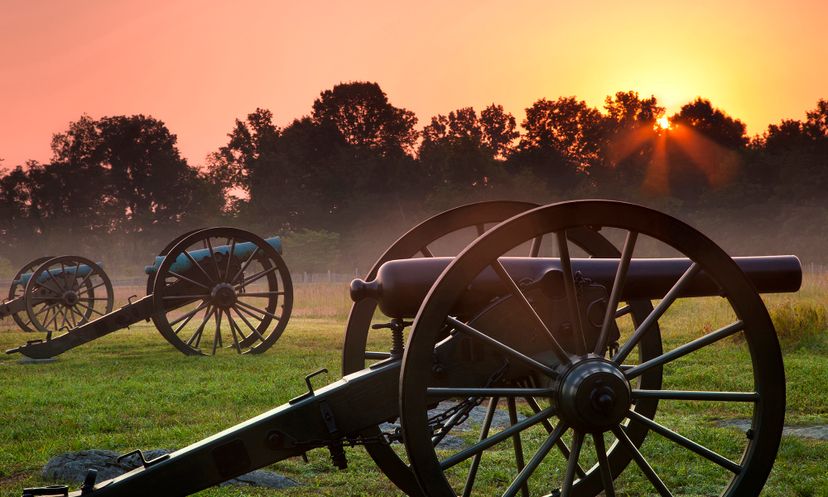
About This Quiz
Although it ended more than a century ago, the scars of the Civil War are still with Americans today. Think you know more than the average Billy Yank or Johnny Reb about the blood and politics behind the war? Find out by taking our Civil War quiz.On May 21, 1861, Richmond, Va. was chosen as the capital of the Confederate states.
Roughly two-thirds of all those killed in the Civil War were lost to disease rather than weapons. Childhood illnesses like measles claimed many lives, while more than a million Union soldiers developed malaria during the war.
Victory was claimed by the northern armies. The seceded states then returned to the Union.
Advertisement
Lee surrendered to Grant at a private home in the village of Appomattox Court House, Virginia on April 9, 1865.
Only seven states -- South Carolina, Georgia, Florida, Mississippi, Alabama, Louisiana and Texas -- seceded at first. But after Lincoln's call for a militia to enforce federal authority, four border states -- Virginia, Arkansas, Tennessee and North Carolina -- seceded and joined the Confederacy.
Both the debate over slavery and over states' rights versus federal power were major causes of the Civil War. The states' rights in question mostly related to slavery, such as the right to take enslaved people from slave states into free states without their being freed.
Advertisement
More than 600,000 American soldiers lost their lives in four years at a time when the total U.S. population was around 34,000,000.
The ships Merrimack and Monitor fought the famous naval battle. The two ships were called ironclads because they were covered with iron. The remains of the Merrimack had been rechristened as the Virginia by the time this battle actually took place, but the battle is still widely known as being between the Monitor and the Merrimack.
More Americans lost their lives in the Civil War than in these four wars combined. To include the names of all those lost, a Civil War monument would have to be 10 times the length of the Vietnam War Memorial in Washington DC.
Advertisement
John Wilkes Booth was tracked by Union troops to a Virginal barn. After setting the barn on fire to smoke Booth out, they eventually shot him to death.
The South felt that the government shouldn't interfere with slavery because it was necessary for a healthy economy and the constitution protected the institution of slavery. The southern states also felt that freeing the slaves would lead to a revolution.
VP Andrew Johnson took on the role of U.S. President once Lincoln died. While John Wilkes Booth originally planned to kill both Johnson and Lincoln, his plans changed, leaving Johnson to lead the mourning nation.
Advertisement
Lincoln told newspaper reporter James Scovel that the Emancipation Proclamation would be "my greatest and most enduring contribution to the history of the war."
When President Lincoln ordered reinforcement of Fort Sumter, in the harbor of Charleston, South Carolina, the first shots of the war were fired. On April 12, 1861, Confederate batteries opened fire on Major Robert Anderson's federal garrison. With the surrender of the fort the next day, all efforts at compromise were abandoned.
Ratified in 1865, the 13th amendment abolished slavery. It was quickly followed by the 14th and 15th amendments, which granted blacks equal citizenship and the right to vote, respectively.
Advertisement
The Battle of Gettysburg was the bloodiest battle, resulting in 51,000 casualties.
The Civil War was also called the War Between the States, the War of the Rebellion, the War for the Union and the War for Southern Independence.
The Battle of Bull Run was also called the Battle of Manassas.
Advertisement
The Battle of Antietam, a major battle of the American Civil War, was fought in September 1862. It was the bloodiest single day of the war. Gettysburg was fought in the following year, 1963. Custer's Last Stand was in 1876 during the Plains Indian War, not the Civil War.
The Siege of Vicksburg, which lasted from May 19 to July 4, 1863, was going on during Gettysburg and was also a decisive battle in the Civil War.
Both sides used hot air balloons during the War, though the North had much greater success with this technology.
Advertisement
On March 3, 1863, the United States Congress enacted a draft. Male citizens could opt out of this by either paying $300 or providing a substitute.
In 1862, Lincoln was an advocate of colonization, believing that whites and blacks would never be able to live in peace. He dropped the idea after a failed plan to send African-Americans to Central America.
John Wilkes Booth shot Lincoln on April 14, 1865, five days after Lee's surrender at Appomattox on April 9, 1865.
Advertisement
Four million African-Americans won their freedom thanks to the Civil War -- representing an "economic loss" of $3 billion to the Southern states.
Here's the oft-repeated story: Confederate Maj. Gen. A.P. Hill, in desperate need of shoes for his men, pursued a tip that there were shoes in Gettysburg. Sadly, this fun tidbit is apocryphal and wasn't documented until 14 years later. In reality, they had to go through Gettysburg, because that's where the roads went.
10 percent of the Union Army consisted of African-Americans.
Advertisement
The South not only used submarines against the North, but their Hunley sub became the first submarine in history to destroy and enemy ship.
There are at least five. After Lincoln delivered the speech, he revised it at least four more times for publication. Each of these drafts is named after the person who received it from Lincoln.
Union commanders chose names based on close rivers or creeks. Confederate commanders typically named battles after the nearest city or town.
Advertisement